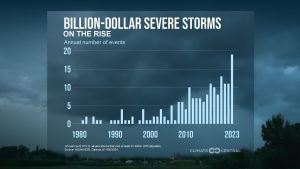How to Protect Your Workforce During Extreme Weather in 2025: A Complete Guide to Emergency Communication Systems
Every year, extreme weather events are becoming more frequent and severe. In 2024, there were 27 extreme weather disasters resulting in at least $1 billion in damages in the United States – the second highest record after the 28 billion-dollar disasters in 2023.
And in 2023, the average number of days between billion-dollar events was 15. To put that in perspective, in 2013, the average number of days between disasters was 40.
With weather-related disasters intensifying, it’s more important than ever to plan ahead, so your employees are prepared when a storm hits.
What Types of Weather Emergencies Threaten Workplaces the Most?

Modern workplaces face an escalating threat from extreme weather events that demand immediate, coordinated response:
2024 Extreme Weather Statistics (Source: NOAA):
- 1,735 confirmed tornadoes in the U.S. – the second highest tornado count on record.
- 2024 was the hottest year on record
- 568 fatalities caused by the 27 billion-dollar events
- $182.7 billion in damages
Most Common Weather Threats to Businesses
1. Severe Thunderstorms and Tornadoes
Severe thunderstorms and tornadoes are the most frequent type of billion-dollar disasters in the United States. In 2024, there were 6 tornado disasters and 11 severe weather billion-dollar events.
These events create sudden workplace emergencies that require immediate evacuations or shelter-in-place decisions.
2. Extreme Heat Events
Heat-related workplace hazards affect millions of workers around the world. In the U.S., nearly 34,000 cases of heat-related injuries caused employees to miss work between 2011 and 2020.
It’s critical for businesses to respond immediately, force mandatory breaks, provide hydration stations, and modify work schedules when the heat rises.
3. Flash Flooding
Flooding events have become more frequent with 26 separate billion-dollar non-hurricane flood events occurring in the last 15 years compared to only 19 in the previous 30 years.
Flash floods create rapidly changing and unpredictable conditions that can trap employees and transportation routes.
4. Winter Storms and Ice Events
Winter weather impacts commutes and facility operations across much of the county. These events require early dismissal decisions, remote work protocols, and backup communication systems during power outages.
The challenge lies in timing decisions correctly to ensure employees are safe while maintaining business operations.
5. Wildfires
Wildfire season now extends longer into fall months. These events are among the most unpredictable, forcing residents and businesses to evacuate at a moment’s notice.
How Should Businesses Manage Employee Safety During Severe Weather Alerts?
Effective management of employee safety during severe weather alerts requires a combination of proactive planning, clear communication, and decisive action.
Businesses must be prepared to quickly disseminate information, provide clear instructions, and ensure that all employees, regardless of their location or work situation, are safe.
Essential Components of Effective Weather Emergency Communication
A robust communication strategy is the backbone of any successful weather emergency response plan. Modern workforces are turning to multi-channel message delivery systems during emergencies to reach employees across all devices and platforms simultaneously.
Here are the essential components:
- Mobile push notifications – Unlike text messages or emails, mobile push notifications grab attention, which is crucial for getting urgent information to employees instantly
- Desktop alerts – Pop-up notifications on computer screens ensure employees at their computers are immediately aware of alerts.
- Smart watch notifications – Alerts are delivered immediately to wearable devices so ensure workers who are in meetings or on the move see the alert.
Real-World Workplace Emergency Response Scenarios
Scenario 1: Tornado Warning at Manufacturing Facility
- Challenge: 200+ employees across multiple shifts and building zones. Ensuring everyone receives the warning quickly and knows where to go for shelter is paramount.
- Solution: Instant facility-wide alert with shelter locations and safety protocols sent via all channels (push notification, desktop alert, SMS, and voice call for supervisors). Clear instructions are provided to move to designated safe areas.
- Result: All employees receive the alert at the same time no matter where they are. Employees can update their location in the alert chat so everyone sees their status in real-time.
Scenario 2: Flash Flooding During Business Hours
- Challenge: Mixed workforce of on-site, remote, and field employees. Need to provide different instructions based on location and potential risks.
- Solution: Location-based alerts with specific instructions per employee group. On-site employees are instructed to stay put or move to higher ground. Remote employees are advised to stay home and avoid travel. Field employees receive instructions to find safe shelter immediately and report their location.
- Result: Tailored alerts and protocols are sent to the right people at the right time.
Which Workplace Emergency Alert Systems Work Best for Weather Events?
When severe weather threatens your business, you need an emergency alert system designed for rapid response and reliable coordination. TeamAlert provides a cloud-based alert notification system that transforms how your team communicates during weather emergencies.
Multi-Platform Emergency Alerting:
TeamAlert works across all devices your team already uses – desktop, laptop, tablet, mobile phone, desk phone, smart watch, email, text – and more. During weather emergencies, your team can raise and receive alerts from any location.
Real-Time Communication During Crisis:
When an alert is raised, TeamAlert creates a private chatroom dedicated to the event. This allows everyone involved to communicate in real-time until the alert is resolved. Team members can upload documents, images, and emergency procedures right into the alert so everyone has access to critical information like evacuation maps or shelter instructions during the emergency.
Unlimited Customizable Alerts for Any Weather Scenario:
With TeamAlert, you can create unlimited custom alerts for any scenario. You control the alert names, what messages are sent when triggered, and who receives each type of alert. This flexibility means you have specific active protocols for tornado warnings, head advisories, flood alerts, or winter storm delays.
Get Ready to Weather the Storm with TeamAlert
Don’t let your team be caught off guard by unpredictable weather. Ensure your team is equipped with the critical foundation of instant, reliable emergency communication to stay safe during extreme weather events.
Discover how TeamAlert can provide your organization with the rapid response system needed to keep everyone informed, protected, and connected when it matters most. Explore how TeamAlert can strengthen your extreme weather preparedness →
About TeamAlert: TeamAlert offers advanced emergency communication solutions tailored for today’s dynamic and distributed workforce. Our platform provides multi-channel alerts, real-time communication, and location-based notifications, ensuring your organization can effectively manage severe weather emergencies.
Download Our Complete Extreme Weather Preparedness Guide: Get Your Free Guide

